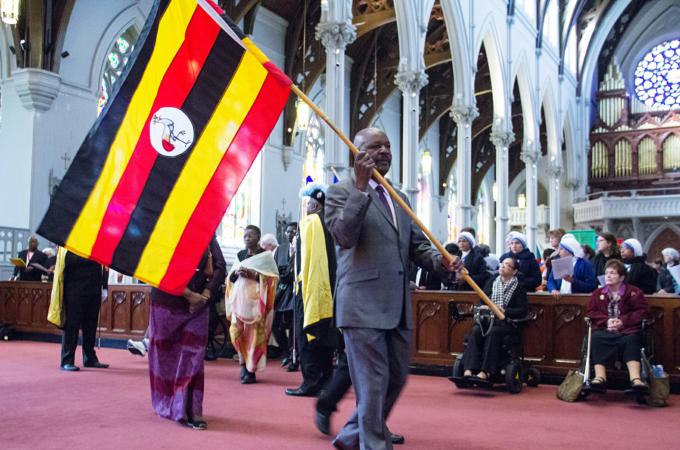Relic of St. Teresa venerated at cathedral on World Mission Sunday
SOUTH END -- A procession of people holding flags, each representing a different country, made its way up the center aisle of the Cathedral of the Holy Cross, Oct. 23, at the start of the Mass of World Mission Sunday.
Organized by the Propagation of the Faith, World Mission Sunday is celebrated yearly and serves as a way to honor different cultures from around the world as well as the work of missionaries around the world.
This year, in celebration of the recent canonization of St. Teresa of Calcutta, a relic of the saint, a vial of her blood, was present during the Mass. Attendees were able to venerate it following the liturgy.
Msgr. William Fay, the newly appointed director of the Pontifical Mission Societies for the Archdiocese of Boston, which include the archdiocesan office of the Propagation of the Faith, acted as the principal celebrant and homilist for the Mass.
In his homily, Msgr. Fay spoke on the importance of prayer, and highlighted three "rules of prayer."
The first rule of prayer is the "rule that we've got to have faith when we begin our prayer," said Msgr. Fay.
He clarified that that means we should pray fully expecting God to help us, and said St. Teresa lived her life with that expectation.
"She knew that God was alive and real, even though, mysteriously in her own life, she didn't feel that presence as much as she saw it at work in the lives of others," he said.
"What a wonderful example she was. Steady and strong all through life, just walking with the presence of the Lord near her. She wanted to hear it more powerfully but didn't, but trusted always that God was near," Msgr. Fay continued.
The second rule of prayer is "to be ready to give God a helping hand," he said. He went on to say that this means prayer should be a conversation with God, and people should be active, not passive, in their faith.
He noted that Pauline-Marie Jaricot, the founder of Society of the Propagation of the Faith, is someone who lived by that rule.
"She was a woman who sensed a call within from God to do something for the missions, especially for those who were missionaries in China, and she had this extraordinary sense that the call was not just a matter of prayer but a matter of sacrificing and inviting other people to join in her work that allowed missionaries to do what they do," said Msgr. Fay.
"She was a beautiful predecessor really, in many ways, to Mother Teresa," he said.
The third and final rule Msgr. Fay listed is to remember that it is "thy will be done," and not "my will be done."
We need to realize that "that life makes no sense at all unless you and I realize that we are what we are and we do what we do because the Lord has given us the life and the grace to be able to do that," he said.
St. Teresa, he continued "was always searching for God's will in her life and putting her own will aside."
Msgr. Fay concluded his homily by thanking those involved in missionary work for attending the Mass, and said that St. Teresa's life and work can be looked at for inspiration.
"Like St. Francis of Assisi, St. Teresa of Calcutta was committed to the idea that the work of the missionary was not to do a lot of talking, but to do a lot of doing," said Msgr. Fay.
"St. Teresa of Calcutta is a beautiful example and she's a vision of what it means to live the missionary vocation," he continued.
The intercessory prayers following the homily were said in six languages -- Luganda, Vietnamese, Cape Verdean Creole, Cantonese, Spanish, and English -- before Msgr. Fay offered the blessing of the World Mission Rosaries.
First introduced to the world in 1951 by the then national director of the Society for the Propagation of the Faith Archbishop Fulton Sheen, World Mission Rosaries are unique because each of the five decades is of a different color, representing the different regions of the world.
At the end of the Mass, a long line formed as people waited to venerate the relic of St. Teresa.
For Dallas Gaughran, venerating the relic reminded her of her family.
"I said a little prayer for my parents, because I learned all about Mother Teresa when I was very young, and my grandmother and my mother would talk about her a lot and read about her when I was a small child in South Africa," she said.
Gaughran said she moved to the United States in the 1970s, but even though she has been in the country for decades, "you never lose where you actually came from."
She said it was wonderful the way the Mass incorporated the cultures of different countries, and said that she could feel the connection between them "in the air."
"It really hit home for me, in many ways, being here today. Very, very special," she said.



















